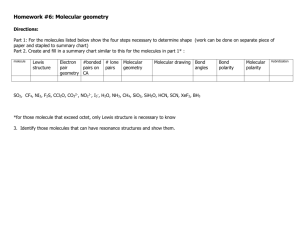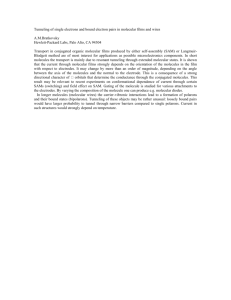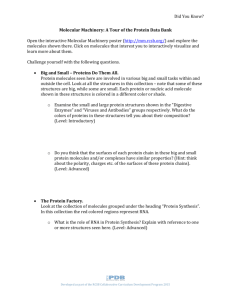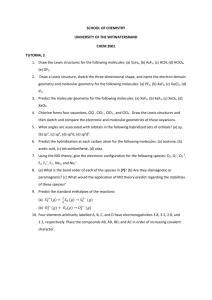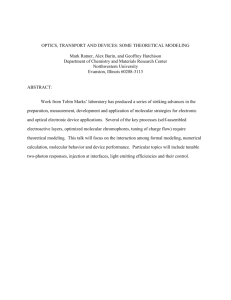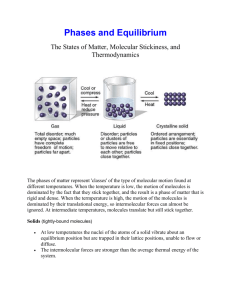Angular momentum
advertisement
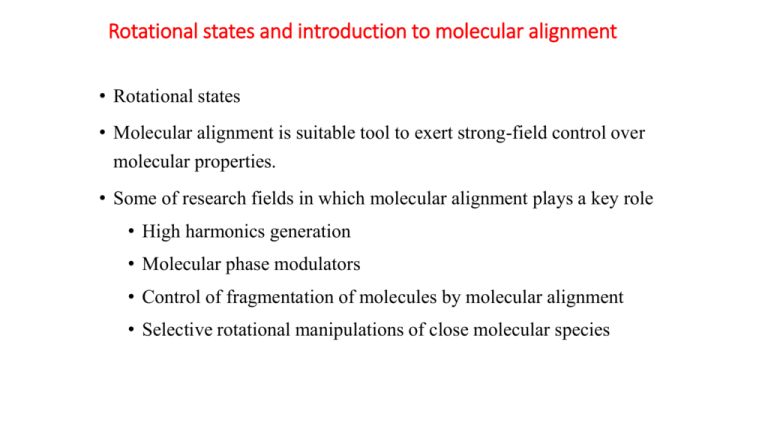
Rotational states and introduction to molecular alignment • Rotational states • Molecular alignment is suitable tool to exert strong-field control over molecular properties. • Some of research fields in which molecular alignment plays a key role • High harmonics generation • Molecular phase modulators • Control of fragmentation of molecules by molecular alignment • Selective rotational manipulations of close molecular species EnerMaterials and acknowledgments: Gamze Kaya and Sunil Anumula, TAMU Cohen-Tannoudji C., Diu B., Laloe F. Quantum mechanics, vol. 1,2 Tom Ziegler , Department of Chemistry , University of Calgary Rigid body angular momentum L r p If we split the whole body into small pieces, then each contribution with magnitude: l l sin p r p iz i i i i Direction: li perpendicular to ri and pi n 2 Lz liz mi vi ri mi ( ri ) ri mi ri i 1 i 1 i 1 i 1 Lz I z angular momentum n n n L I kinetic energy K I / 2 2 Courtesy of Tom Ziegler , Department of Chemistry , University of Calgary Quantum mechanical angular momentum Courtesy of Tom Ziegler , Department of Chemistry , University of Calgary Courtesy of Tom Ziegler , Department of Chemistry , University of Calgary Courtesy of Tom Ziegler , Department of Chemistry , University of Calgary Courtesy of Tom Ziegler , Department of Chemistry , University of Calgary Courtesy of Tom Ziegler , Department of Chemistry , University of Calgary Courtesy of Tom Ziegler , Department of Chemistry , University of Calgary Shapes of spherical harmonic functions l 0 1 m 2 3 3 2 1 0 -1 -2 First Sixteen Spherical Harmonic Functions -3 Rotational energies of a molecule in a particular vibrational state J is the total orbital angular momentum of the whole molecule B is called rotational constant D is a centrifugal distortion constant (a correction due to molecular stretching) Rotational molecular states: random alignment Energy corresponding to a rotational level (with angular quantum number J) is given by: E= B J (J+1) where J =1,2,3,……. Difference between two energy states: ΔE= EJ-EJ-1 = 2BJ which is very small and can be archived at room temperature, i.e. kT~ ΔE In general, an ensemble of molecules is in a thermal distribution of multiple J states. Molecules can be thought of as randomly aligned at normal room temperature, i.e. their the directions of their axes are isotropically distributed. Effects of the laser field on molecular state Laser field If the laser field frequency is far from resonance, the Hamiltonian has the following contributions H(t) = BJ2 + V µ(θ) + V 𝜶(θ) Corresponds to field free rotational energy. Corresponds to permanent dipole moment Corresponds to induced dipole moment Induced dipole momet Time period of IR field at 800 nm (2.66 fs) < typical rotational period of molecules Effect of a short laser pulse on molecular alignment: adiabatic and non adiabatic regimes Trev 1/ (2 Bc) Rotational time period of molecule can be written as This value ranges from few femto seconds to pico seconds Different types of interactions with the laser field: 1. Adiabatic: Trot < pulse width Dipole is induced due to interaction between laser field and molecules, which causes the molecules to align along the laser field. Molecules follow laser fields, as if it were static fields. 2. Non adiabatic ( field free, or impulsive): Trot > pulse width An ensemble of Rotational wave packets of molecules are created by applying short intense laser filed. These molecules can dynamically rotate their molecular axes after the laser pulse. And these rotating molecules repeatedly come to a phase and diphase at a period of certain revival time in a field free environment. Molecular rotational constants B 1 2Trev c Table. 1 Our experimental data and comparison to theoretical molecular rotational constants from the literature. N₂ O₂ CO₂ CO C₂H₂ Our Experimental data (cm-1) 2.0102±0.011 1.4611±0.022 0.3971±0.018 1.9393±0.004 1.1801±0.003 Theoretical (cm-1) 1.9896a 1.4297a 0.3902a 1.9313a 1.1766b a W. M. Haynes, CRC Handbook of Chemistry and Physics: A Ready-Reference Book of Chemical and Physical Data. Boca Raton, FL.: CRC Press, 2011. b M. Herman, A. Campargue, M. I. El Idrissi, and J. Vander Auwera, "Vibrational Spectroscopic Database on Acetylene," Journal of Physical and Chemical Reference Data 32, 921-1361 (2003). Courtesy of Gamze Kaya Molecules in external laser field When an electric dipole with a dipole moment ‘P’ is placed in an electric field, E, The net torque about an axis through “O” is given as Τ=PxE Then, internal energy of the dipole is given as U = -P.E In case of induced polarization in molecules, we can write P= α. E , where, α is the polarizability tensor of molecule. Internal energy of molecule becomes U= - α. E. E Polarizability tensor of a linear molecule In case of linear molecules: Details of derivation of the potential energy in a laser field So, Molecules in external laser field The degree of alignment of a molecular sample is characterized by the expectation value of To find the wave function one needs to solve the Schroedinger equation Table. 1 Relevant parameters for the molecules investigated in the experiment Molecule Trev(ps) Ip(eV) HOMO symmetry N₂ 8.4 15.6 σg O₂ 11.6 12.7 u CO₂ 42.7 13.8 g CO 8.64 14.01 σg C₂H₂ 14.2 12.9 u O₂ CO Highest occupied molecular orbital (HOMO) of the molecules investigated. Courtesy of Gamze Kaya Diagram of Molecular orbitals for N2 σ*u LUMO HOMO π*g σg πu σ*u σg HOMO : highest occupied molecular orbital LUMO : lowest unoccupied molecular orbital N2 has 10 valence electrons. The degree of alignment of molecules is characterized by cos 2 . The rotational wavepacket evolution in time ( , cJ m J , m exp( i J ( J 1) ) J ,m the time is given in units of Trev The alignment factor: cos 2 ( ) ( , cos 2 ( , * 2 c c J ', m ' cos J , m exp( i J '( J ' 1) J ( J 1) ) J ' m' J m J ', m ' J , m J , J ' J , J '2 m,m ' JJ ' Infrared spectroscopy does not involve electric dipole transitions. Thus, no electric dipole moment is required; the principal selection rule for linear molecules here is J 0, 2 J J ' the time-dependent phase disappears J J ' 2 J , J 2 exp( i (4 J 6)) Zon (1976), Friedrich + Herschbach (1995), Seideman (1995) 24 Isotropic case Experimental results of N2 (for 2:1 ratio of even and odd J states) tot el vib rot ns Weight: 14 N2 14 N is a Boson (I=1), so tot SYM SYM S S el =SYM, ( 3 g ), hence: Trev S AS AS Trev 4 S 2 3Trev 4 2 1 2:1 Expected ratio of contributions Trev Molecular revivals of N2 molecules by linearly polarized probe pulse I0=7.2 10^13 W/cm2; measured by detecting the ionization yield. Courtesy of Gamze Kaya Finding excited rotational wave packet Ortigoso et al. J. Chem. Phys., Vol. 110, No. 8, 3874, 1999 Markus Gühr, SLAC National Accelerator Laboratory Calculations of the rotational wavepacket at maximal alignment for different temperatures and intensities Calculated with the code of Markus Gühr, SLAC National Accelerator Laboratory Conclusions: effects due to alignment The alignment effect manifests itself in such processes as ionization, high harmonic generation; even configuration of molecular orbitals can be tested. Fragmentation of molecules also changes due to alignment. Alignment introduces changes of the refractive index, introduces anisotropy and birefringence. The alignment effect is reducing with temperature, but increasing with the intensity, though the intensity still should be below the values when significant ionization occurs.
